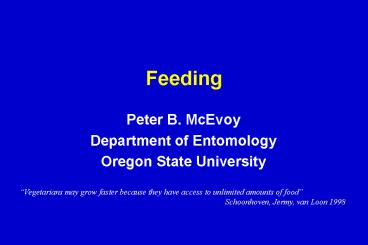Feeding PowerPoint PPT Presentation
1 / 30
Title: Feeding
1
Feeding
- Peter B. McEvoy
- Department of Entomology
- Oregon State University
Vegetarians may grow faster because they have
access to unlimited amounts of food Schoonhoven,
Jermy, van Loon 1998
2
Questions
- What do plants offer to insects in the way of
nutrition? - What do insects need for optimal growth and
reproduction? - What is the basis for the claim that plants
supply food that is of marginal quality?
3
Outline
- Specialization by host species and plant parts
- Insect feeding systems
- Plants are suboptimal food
- Nitrogen and Water
- Plant architecture
- Consumption and Utilization
- Suboptimal food and compensatory feeding
- Allelochemicals and food utilization
- Deterrents
- Toxins
- Digestibility reducers
- Using allelochemicals to insect advantage
4
Evolutionary Hurdles to Feeding and Living on
Seed Plants (Southwood 1972)
- Among insect orders herbivory(9 minor,3 major)
is less widespread than scavenging(21,9) or
carnivory (19,4) - Obstacles to life on seed plants
- Nutrition How do we know plants are sub-optimal
food? - Attachment or Holding On
- Desiccation
- Host finding, including synchronization of life
cycles
5
Comparing Chemical Composition of Plants and
Insects
None of average values found in insects, except
Mg, equals average in plants Nitrogen (and Na)
deserve special attention
6
Conversion Efficiencies Herbivores (8-21) lt
Carnivores (45-50)
Converting plants to animals
Converting animals to animals
7
Variation in N in Plant Parts Compared to
Animals (Log Scale)
Animals 8-14, Plants 2-4 N Also compare
calories and water
8
Seasonal Variation in Nitrogen and Water in
Foliage of Trees and Herbs
9
Host-plant Specialization
10
Levels of Specialization
11
Polyphagous Species
12
Leaf Chewers
13
Mechanics of Leaf ChewingVariation Among Instars
and Between Species
14
Sap-Tappers
15
Stylet Pathway
16
Varying Nature of Plant Sapsand Modes of
Exploitation(Schoonhoven et al. 1998 Pp 87-89)
- Xylem negative pressure, low highly suitable N,
no sugar, circumvents allelochemicals - Phloem positive pressure, higher suitable N,
ample sugar, circumvents allelochemicals - Mesophyll neutral pressure, encounters
allelochemicals
17
Architectural Barriers for Spittlebugs Axil Width
McEvoy 1986
18
Architectural Barriers for Spittlebugs Trichomes
Hoffman and McEvoy 1985, 1986
19
Architectural Barriers for Spittlebugs Tissue
Hardness
(Below) Progressively fewer on leaves, lower on
stem, as insects develop
(Above) Tissue hardness increases with distance
from apex
20
Architectural Barriers Stem Cross Sections
Stylet reaches xylem
Stylet blocked by lignified bundle
21
Allelochemicals
- Allelochemicals
- Major classes of secondary plant compounds
involved in insect-plant interactions (Harborne
1977) - Origin in primary plant metabolism (Norris and
Kogan 1980) - Herbivore responses to allelochemicals
- Toxins defense and counter defense
- Digestibility reducers defense and counter
defense - Using allelochemicals to insect advantage
- Cardiac glycosides, milkweeds, monarch
butterflies and blue-jays - Pyrrolizidine alkaloids, ragwort, moths and
butterflies
22
Consumption and Utlization
- Measuring food consumed, digested and
assimilated, excreted, metabolized, and converted
into biomass - Measures of performance (Calow 1977)
- Efficiency of transforming inputs into useful
outputs - A/C assimilation efficiency
- G/C gross growth efficiency
- G/A net growth efficiency
- Speed of transforming inputs into outputs
- Consumption (C)
- Assimilation (A)
- Growth (G)
- Respiration (R)
- Reproduction (F)
- Homeostatic ability or the capacity to buffer
production of useful outputs against changes in
inputs
23
Some Fundamental Constraints
- Resource limitation and trade-offs When total
amount of resource available for expenditure is
limited, various activities of the organism
(demands) must compete for a share of the supply - Absorption inefficiency- only a fraction of
ingested energy is digested and absorbed and
actually available for metabolism - Second Law of thermodynamics no spontaneous
transformation of energy into potential energy
(.e.g. food into protoplasm) is 100 efficient
because some of the energy is always dispersed
into unavailable heat - Speed vs. Efficiency increase in one usually
brings about a decrease in the other impossible
to maximize both. - Specialization vs Generalization The rate
and/or efficiency of transformation of inputs
into useful output increases with specialization
or practice
24
Growth in Relation to Nitrogen and Water
25
As the N Content Increases, Insects Become More
Efficient in Converting Plant Material Consumed
(C) Into Body Tissue (G)
G/C
N
26
Higher Growth Rate Might Be Obtained by
Increasing Food Intake Rate or Increasing
Utilization but for the Constraint That
- increasing consumption rate
- decreases gross growth efficiency
- Clarifying cause and effect is slow growth a
cause or consequence of reduced efficiency (pp
87-98)
27
What Limits homeostatic AbilityDecreased
Assimilation Efficiency or Decreased Growth
Efficiency due to Increased Maintenance Costs?
- G/T C/T x A/C x G/A
28
Constraints on Compensatory Feeding
- Trade-off between rate and efficiency increase
C decrease A/C - Increase C to compensate for deficiency in one
nutrient may lead to excess of another - Increase C may lead to intoxication due to
increase in allelochemicals - Increase C may increase exposure to natural
enemies
29
Metabolic Cost of Feeding
McEvoy 1984
30
Discussion
- Why has plant chemistry received more attention
that architectural features as influences on
insect feeding? - Feeding strategy reflects attributes of the
resource and the organism how does feeding
strategy constrain life styles (body size,
interactions with other organisms, impact on
plants) ? - If nutritional inadequacy is a major determinant
of host plant resistance, might herbivory be a
selective force shaping primary metabolism of
plants (see Berenbaum)? - Why is total N a poor predictor of feeding
performance? Why do fertilization experiments
yield mixed results? - Why does drought sometimes detrimental, sometimes
beneficial to the feeding insect? - What are the magnitudes and sources of error in
quantifying food intake and utilization?

